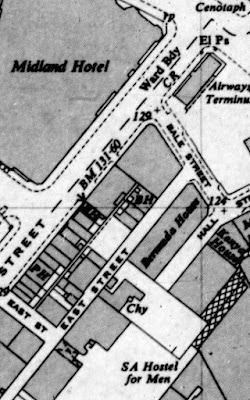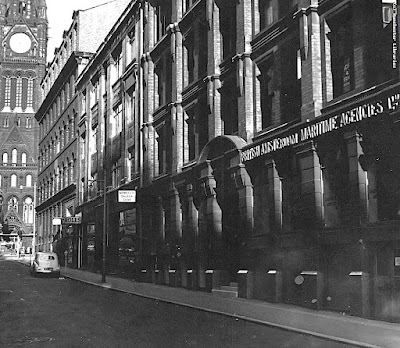Now, Tommy Ducks remains a legendary place in the history of the city.
There will be those who remember the underwear pined on the ceiling, along with the coffin that once took pride of place in the bar, and of course the ongoing debates about its name, and just how it came to be demolished on a night in February 1993.
I don’t remember the coffin, because by the time I was roaming the city centre pubs it had been removed by its owner to the Nag’s Head on Jackson’s Row, although to be accurate the coffin resided in the room to the left of the Lloyd Street entrance.
My friend Elaine who worked at Tommy’s, offered up the story of what happened to the coffin along with a press clipping from the Manchester Evening News and the story of how Mr. Ken Riggs who had run the pub through the 1970s took it with him when he left for the Nags’ Head leaving the new landlord, Mr. Ormod to substitute a headstone in its memory because “customers missed the coffin”.
All of which means that Tommy Ducks on East Street had always been more than just a place to visit for a quiet drink.
Looking through the wealth of material on the pubs including the speculation on its name and its origins I decided to go back to basics, and trawl the historic records.
Once, numbers 8 and 10 East Street were part of a long row of terraced houses, which were there by 1848 and were built sometime between then and 1819.
From the 1840s through to 1864 what became Tommy Ducks was just a residential property, consisting of just four rooms, with a cellar.
The 1860s Rate Books show that both the house and cellar were rented out s dwelling places.*
But during 1864 a James Robinson moved in and opened up a beer house, at which point both the rent and the rates doubled, from a rent of £9 to £18 and a new rate of £15 from just £8.
The Robinson’s tenure was short and mid way through 1867 the place was taken over by Thomas and Charlotte Duckworth, who were granted a license for selling beer under the title of the Princess Tavern.
They had already run beer shops across the city. In 1861 they were on St James Street, off Charlotte Street, dispensing cheer and beer, and four years later were doing the same on Hancock Street which was off Rochdale Road.
And while I haven’t yet made a link, there was an Ellen Duckworth running a beer house at 20-22 Hancock Street in 1863.
The Duckworth’s remained at East Street into the early 1880s, although the business is listed in the name of Charlotte in 1878.
And that pretty much is it, for the rest of the 19th century and through the next it continued to operate as a beer house rather than a pub and is listed as such as late as 1950, and there are images of it with the old Princess Tavern name alongside that of Tommy Ducks.**
During those two centuries, it was surrounded by industrial units, saw most of the rest of the terrace disappear, including the intriguing court, called Faulkner’s Square.
Leaving me just to invite anyone with memories of the pub to participate in a
“SHORT LOCAL FILM OPPORTUNITY”, the organiser of which have written,
“We are looking for interviewees on a project about the legacy of the Tommy Ducks pub, which used to stand opposite of the Midlands Hotel on what is now lower Mosley St.
This legendary pub is remembered in countless stories, including those of its peculiar decor and unfortunate demolition.
We are hoping to explore the mythology and memory of the pub through personal testimony/interview.
If you have stories and memories to share, either via Zoom or face to face (in the outdoors) in a COVID risk-assessed and friendly environment, please email tilliequattrone@gmail.com.”Location; Manchester
Picture; Elaine at Tommy Duck's courtesy of Elaine Archer, the pub in 1978/9, from the collection of Andy Robertson and East Street circa 1903 from Gould's Fire Insurance Maps, 1880-1903, courtesy of Digital Archives Association, http://www.digitalarchives.co.uk/ EasStreet in 1950, from the OS map of Manchester & Salord 1950
Painting; Tommy Ducks © 2011 Peter Topping
Web: www.paintingsfrompictures.co.uk
Next; more on the Duckworth family
Manchester Rate Books, 1860-1900, Census records, 1841-1911 and Directories, 1841-1911
**Tommy Ducks, 1972, m50660, courtesy of Manchester Libraries, Information and Archives, Manchester City Council, http://images.manchester.gov.uk/index.php?session=pass


















.jpeg)








crop5.jpeg)
crop.jpeg)



















